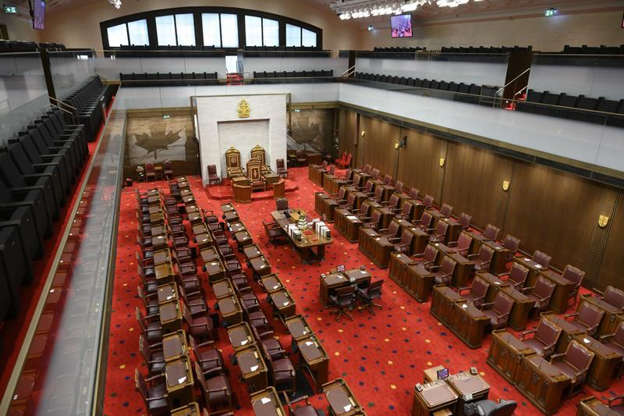Alberta
Alberta will now allow wood-building construction for up to 12 storeys

From the Province of Alberta
Reducing red tape for wood-building construction

Municipal Affairs Minister Kaycee Madu announced the change Friday, as part of Red Tape Reduction Awareness Week.
While other jurisdictions in Canada, like British Columbia, currently allow for 12-storey wood construction, Alberta will become the first province in Canada to allow the practice province-wide.
“Not only will this decision support the forestry industry and land developers, it will provide affordability to homebuyers, bolster employment, and give Alberta a competitive advantage. We made this change knowing that mass timber products are safe and that these buildings will meet all necessary standards.”
Current Alberta and national building codes allow wood-building construction for up to six storeys, but the next edition of the National Building Code – anticipated for publication at the end of 2020 – will allow for the use of tall wood construction with fire-resistant material for up to 12 storeys.
Alberta will issue a notice – based on technical provisions developed for the next edition of the National Building Code – to allow early use of tall wood or mass timber construction for up to 12 storeys using fire-resistant material in time for the upcoming construction season.
“We commend the Government of Alberta for advancing the use of wood-building construction of up to 12 storeys with this province-wide variance. By building with products that are made locally, we are supporting thousands of jobs in small communities and large cities throughout the province. From people working in sawmills, to value-add facilities, to jobs in construction and transportation, everyone benefits from this change. Moreover, because wood is fully renewable and has a low carbon footprint, our environment benefits, too.”
New technology makes taller wood construction feasible

Advancements in fire-protection and wood-product technology are allowing for the construction of taller wood buildings without compromising safety.
The building codes will require tall wood buildings to be built as encapsulated mass timber construction, where the solid or engineered wood has been surrounded by fire-resistive material. Buildings of mass timber construction will also be fully sprinklered.
“BILD Alberta is excited to see the Government of Alberta take steps to modernize construction, reduce red tape and address environmental needs by allowing innovative techniques to deliver the homes and buildings people need. This provides our industry and member companies with more options in meeting the housing affordability needs of Albertans.”
Quick facts
- Wood buildings taller than six storeys have been built in Vancouver (University of British Columbia’s 18-storey Brock Commons), Europe, the United States, and other jurisdictions around the world.
- Mass or laminated timber has excellent durability and seismic, fire, and acoustic safety performance.
- The encapsulated mass-timber construction component of the 2020 National Building Code has already been reviewed by the National Building Code committees and fire-safety specialists, structural engineers, architects, scientists, and builders.
Economic impact of tall wood buildings
- Potential to create about 60 jobs per construction site and up to 400 jobs per new sawmill and production sites.
- A growth in demand for lumber, for example, 100-million board feet, about $40-million worth of lumber, is the equivalent to about two mills the size of Boucher Bros Lumber.

Minister Madu tours Western Archrib with (L-R) Paul Whittaker, Scott Fash of BILD, Dale Beesley, Municipal Affairs, and Andre Lema, of Western Archrib.
Alberta
Made in Alberta! Province makes it easier to support local products with Buy Local program

Show your Alberta side. Buy Local. |
When the going gets tough, Albertans stick together. That’s why Alberta’s government is launching a new campaign to benefit hard-working Albertans.
Global uncertainty is threatening the livelihoods of hard-working Alberta farmers, ranchers, processors and their families. The ‘Buy Local’ campaign, recently launched by Alberta’s government, encourages consumers to eat, drink and buy local to show our unified support for the province’s agriculture and food industry.
The government’s ‘Buy Local’ campaign encourages consumers to buy products from Alberta’s hard-working farmers, ranchers and food processors that produce safe, nutritious food for Albertans, Canadians and the world.
“It’s time to let these hard-working Albertans know we have their back. Now, more than ever, we need to shop local and buy made-in-Alberta products. The next time you are grocery shopping or go out for dinner or a drink with your friends or family, support local to demonstrate your Alberta pride. We are pleased tariffs don’t impact the ag industry right now and will keep advocating for our ag industry.”
Alberta’s government supports consumer choice. We are providing tools to help folks easily identify Alberta- and Canadian-made foods and products. Choosing local products keeps Albertans’ hard-earned dollars in our province. Whether it is farm-fresh vegetables, potatoes, honey, craft beer, frozen food or our world-renowned beef, Alberta has an abundance of fresh foods produced right on our doorstep.
Quick facts
- This summer, Albertans can support local at more than 150 farmers’ markets across the province and meet the folks who make, bake and grow our food.
- In March 2023, the Alberta government launched the ‘Made in Alberta’ voluntary food and beverage labelling program to support local agriculture and food sectors.
- Through direct connections with processors, the program has created the momentum to continue expanding consumer awareness about the ‘Made in Alberta’ label to help shoppers quickly identify foods and beverages produced in our province.
- Made in Alberta product catalogue website
Related information
Alberta
Province to expand services provided by Alberta Sheriffs: New policing option for municipalities

Expanding municipal police service options |
Proposed amendments would help ensure Alberta’s evolving public safety needs are met while also giving municipalities more options for local policing.
As first announced with the introduction of the Public Safety Statutes Amendment Act, 2024, Alberta’s government is considering creating a new independent agency police service to assume the police-like duties currently performed by Alberta Sheriffs. If passed, Bill 49 would lay additional groundwork for the new police service.
Proposed amendments to the Police Act recognize the unique challenges faced by different communities and seek to empower local governments to adopt strategies that effectively respond to their specific safety concerns, enhancing overall public safety across the province.
If passed, Bill 49 would specify that the new agency would be a Crown corporation with an independent board of directors to oversee its day-to-day operations. The new agency would be operationally independent from the government, consistent with all police services in Alberta. Unlike the Alberta Sheriffs, officers in the new police service would be directly employed by the police service rather than by the government.
“With this bill, we are taking the necessary steps to address the unique public safety concerns in communities across Alberta. As we work towards creating an independent agency police service, we are providing an essential component of Alberta’s police framework for years to come. Our aim is for the new agency is to ensure that Albertans are safe in their communities and receive the best possible service when they need it most.”
Additional amendments would allow municipalities to select the new agency as their local police service once it becomes fully operational and the necessary standards, capacity and frameworks are in place. Alberta’s government is committed to ensuring the new agency works collaboratively with all police services to meet the province’s evolving public safety needs and improve law enforcement response times, particularly in rural communities. While the RCMP would remain the official provincial police service, municipalities would have a new option for their local policing needs.
Once established, the agency would strengthen Alberta’s existing policing model and complement the province’s current police services, which include the RCMP, Indigenous police services and municipal police. It would help fill gaps and ensure law enforcement resources are deployed efficiently across the province.
Related information
-

 espionage10 hours ago
espionage10 hours agoEx-NYPD Cop Jailed in Beijing’s Transnational Repatriation Plot, Canada Remains Soft Target
-

 2025 Federal Election1 day ago
2025 Federal Election1 day agoBureau Exclusive: Chinese Election Interference Network Tied to Senate Breach Investigation
-

 2025 Federal Election1 day ago
2025 Federal Election1 day agoNeil Young + Carney / Freedom Bros
-

 2025 Federal Election18 hours ago
2025 Federal Election18 hours agoTucker Carlson Interviews Maxime Bernier: Trump’s Tariffs, Mass Immigration, and the Oncoming Canadian Revolution
-

 2025 Federal Election17 hours ago
2025 Federal Election17 hours agoCanada drops retaliatory tariffs on automakers, pauses other tariffs
-

 2025 Federal Election2 days ago
2025 Federal Election2 days agoMEI-Ipsos poll: 56 per cent of Canadians support increasing access to non-governmental healthcare providers
-

 2025 Federal Election1 day ago
2025 Federal Election1 day agoRCMP Whistleblowers Accuse Members of Mark Carney’s Inner Circle of Security Breaches and Surveillance
-

 Autism1 day ago
Autism1 day agoRFK Jr. Exposes a Chilling New Autism Reality








